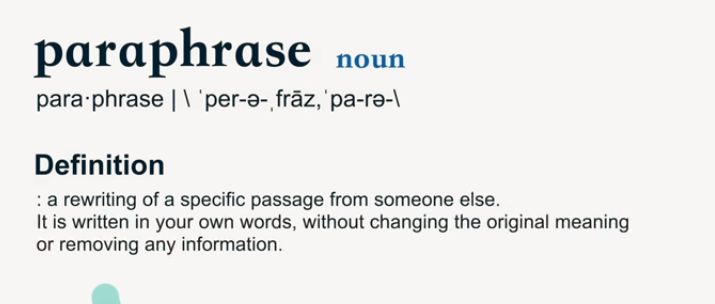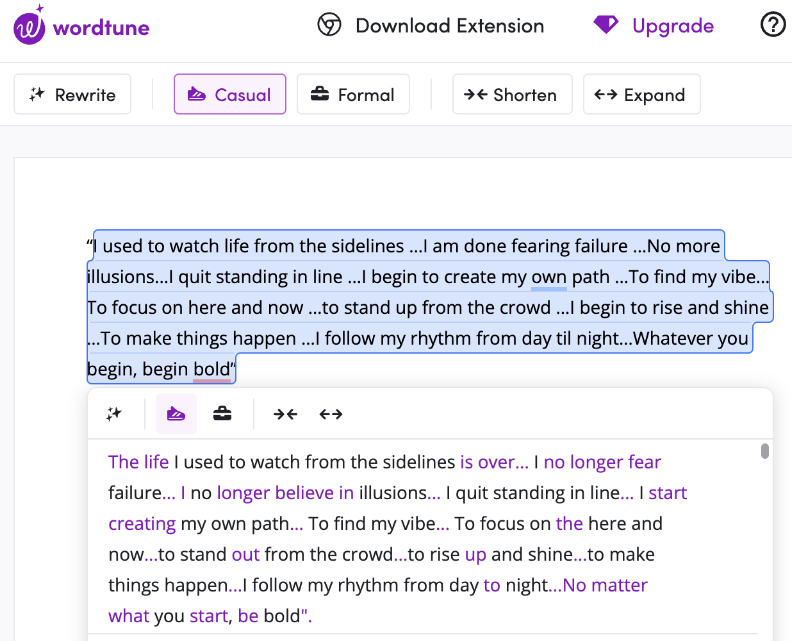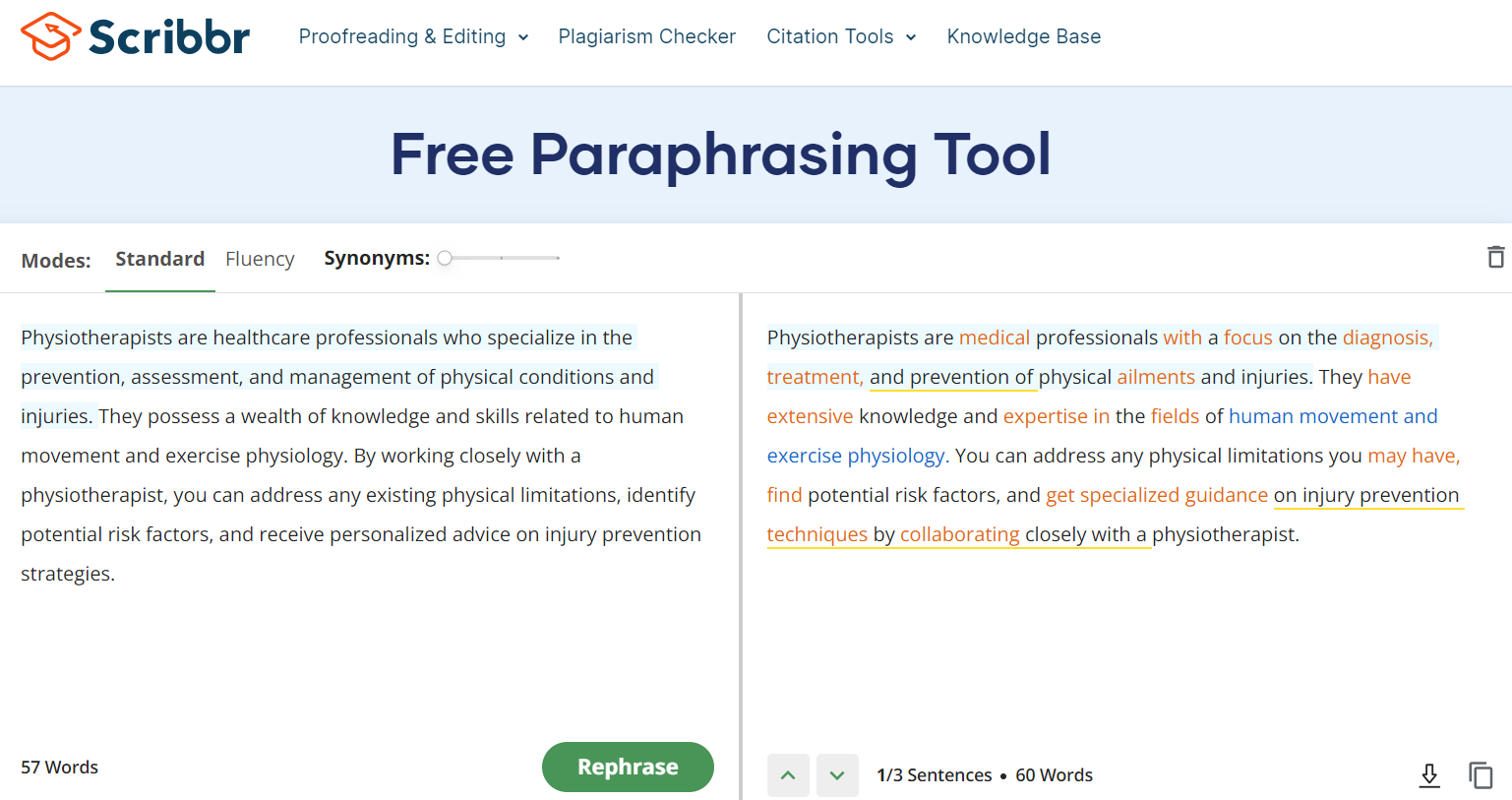Discover top guides, trends, tips and expertise from AIO Writers

Paraphrasing is like giving a fresh makeover to someone else’s words or ideas while retaining the original meaning. It’s a super useful skill, whether you’re a student trying to avoid plagiarism or a professional writer looking to express something more clearly.
Learning how to paraphrase effectively means understanding the original text thoroughly. Read it several times to grasp the key points. Then, put the original text away, and in your own words, explain what you’ve understood from it. Try to express the same ideas using different words, sentence structures, and maybe even a different order of ideas.
But remember, you’re not adding or subtracting any new concepts; you’re just giving it a fresh twist.
As the old adage goes, practice makes perfect. The more you practice how to paraphrase, the better you’ll get at it. It’s a valuable skill for academic writing, summarizing articles, or even just explaining a complex concept to a friend in a simpler way.
Let’s look at some practical techniques and examples of how to paraphrase even the most complex text into easy-to-understand content.
Table Of Contents:
- What is Paraphrasing?
- Paraphrasing vs. Quoting
- Paraphrasing vs. Summarizing
- Types of Paraphrasing
- The Four R’s of Paraphrasing
- How to Paraphrase: 5 Easy Steps
- Best Paraphrasing Tools
- Plagiarism and Citation
- FAQs – How to Paraphrase
- Conclusion
What is Paraphrasing?
When you’re trying to learn what is grammar, paraphrasing should be on your radar.
The art of paraphrasing is a key writing skill. At its core, it’s about expressing someone else’s ideas in your own unique words.
But let me tell you something surprising: this isn’t just some simple task of swapping out one word for another. It’s more like a complex dance where you’re trying to match the rhythm and style of an original text, while also adding your own flair.
Paraphrasing plays a crucial role not just in maintaining academic integrity but also in ensuring SEO content ranks well. You see, when we directly copy someone else’s work without giving them credit, that’s called plagiarism. Professors don’t want that. Google doesn’t want that.
To avoid the unsavory consequences of plagiarized content, we use different words or phrases to express the same meaning as the original text.
In fact, according to my experience working with students and writers over the years, paraphrasing is usually preferred over direct quotes because it demonstrates understanding rather than simply repeating what has been said.
Here’s something to think about: Would Picasso have become renowned if he’d copied every stroke from Monet? Nope. He took inspiration from others but put his spin on things too. That’s what paraphrasing is all about.

Definition of paraphrase from Scribbr
Paraphrasing vs. Quoting
As a writer, it’s crucial to know when to paraphrase and when to quote. This knowledge can significantly enhance the quality of your writing while avoiding issues of plagiarism.
Why paraphrase?
- Fosters understanding: Paraphrasing helps ensure that you truly understand the source material as it requires deep comprehension before expressing the idea differently.
- Maintains flow: Direct quotes might disrupt the flow of your content, especially if they use language or style different from yours. By paraphrasing, you maintain consistency in tone and style throughout your piece.
- Avoids plagiarism: Knowing how to paraphrase correctly lets you pick up others’ ideas without plagiarizing their work.
Why quote?
Direct quotations should be done sparingly but it does have a place in writing under these circumstances:
- Precision: If precision is necessary and altering wording could change meaning or impact – such as with statistics, definitions, laws, or direct statements – quoting ensures accuracy.
- Credibility: Direct quotes from experts in relevant fields can boost credibility by providing authoritative support for arguments made within the text.
- Authority: If the person quoted has significant authority or relevance to your content, using their exact words can add weight to your points.
Understanding when and how to paraphrase or quote is a vital part of producing high-quality content. By mastering these skills, you will be able to create engaging and original material that resonates with readers while respecting intellectual property rights.
Paraphrasing vs. Summarizing
Paraphrasing and summarizing are two distinct techniques that serve unique purposes in your writing. How are they different and when should you use them?
Paraphrasing: Paraphrasing involves taking a specific passage from a source and rewording it to fit into your own narrative or argument. The length of a paraphrased section usually mirrors that of the original text, albeit sometimes slightly shorter.
To master this technique, you need to have excellent comprehension skills and be able to retain core ideas while altering sentence structure and vocabulary without changing meaning. Resources such as Purdue Global’s guide on how to paraphrase can provide useful tips for honing these skills.
Summarizing: On the other hand, summarization involves distilling longer pieces of writing down to their key points, resulting in content significantly shorter than the original version. Think about book reviews or abstracts at the start of academic papers.
This technique requires identifying overarching themes or arguments rather than focusing on detailed specifics within a piece. For instance, if you want more general information about an entire article rather than quoting specific details from it directly, then summarizing would be appropriate.
The choice between paraphrasing and summarizing depends largely on your objectives: do you wish to present precise data (paraphrase) or give an overview (summarize)?
Both tools play crucial roles in presenting sourced information effectively within any form of written communication – from essays through blog posts to business reports.
Types of Paraphrasing
There are three primary types of paraphrasing based on the intent of the writer: acknowledging, organizing, and changing focus.
Acknowledging
This type of paraphrasing serves the purpose of demonstrating your comprehension, typically when you’re aiming to respond to a question. If you find yourself struggling to rephrase the information in a clear and straightforward manner, it’s a sign that you might need to put in some extra effort.
Organizing
This method is all about simplifying a sequence of ideas or events, providing a broader overview with fewer details. Picture it as creating a numbered list or an outline that guides you through the information from start to finish, helping you organize it neatly.
Changing Focus
Paraphrasing isn’t just about changing words; it’s about altering the focus of the information. You can make it more abstract and big-picture or hone in on the concrete specifics. This versatility in paraphrasing can help you connect with diverse audiences by tailoring the information to resonate with them more effectively.
All these forms of paraphrasing are invaluable tools for content creators, allowing them to adapt and reframe existing information in ways that resonate with their audiences. As you continue your journey into the world of content creation, mastering these types will help ensure your work is both engaging and effective.
The Four R’s of Paraphrasing
The key to how to paraphrase effectively is to follow the four R’s: Rewrite, Rearrange, Realize, and Recheck.
Rewrite
The first step in effective paraphrasing is to look for words or phrases that closely mimic the original text. Replace any instances that appear overly similar in your paraphrase, paying particular attention to lengthy or less common terminology.
Rearrange
Rearranging the structure of a sentence can transform its tone, style, and overall clarity. Consider relocating clauses within the sentence, testing both at the beginning and the end, to discover fresh ways to make your writing more engaging and comprehensible.
Realize
Certain words may be immovable. When dealing with specific, unalterable details like city names or dates, your best bet is to work around that and possibly use quotation marks. In such cases, maintaining originality is paramount to steer clear of unintentional plagiarism.
Recheck
Lastly, recheck your work. This involves going over your writing again to ensure that it aligns well with the ideas you’re paraphrasing and citing. It’s always beneficial to revise a few times more for quality assurance.
How to Paraphrase: 5 Easy Steps
Paraphrasing is a crucial skill in academic writing and content creation. It allows you to incorporate the ideas of others into your work while maintaining your own unique voice and style. However, paraphrasing must be done correctly to avoid plagiarism.
To start with, let’s understand what paraphrasing entails — it involves rewriting someone else’s text in a way that changes the wording but retains the original meaning. It’s not about copying verbatim or changing just a few words here and there. It requires comprehension of the source material and the ability to express those concepts differently.
Here’s a 5-step guide on how to paraphrase correctly.
Step 1: Read through the original text several times, ensuring you fully comprehend its meaning.
Step 2: Jot down key points from the passage so that you capture the core ideas rather than specific language choices used by the author.
Step 3: Use these notes as a guide for crafting your own version of this information without looking at it. Use synonyms and different sentence structures, change sentences in the passive voice into the active voice, and break down long sentences or combine shorter ones, all while preserving the original intent.
Step 4: Compare the paraphrased text to the original. If you find phrases that are too similar, make changes.
Step 5: Always cite the source of your text even after paraphrasing it to avoid violating plagiarism rules. For more on how to properly attribute written work, check out this comprehensive guide on citation styles.
Best Paraphrasing Tools
If you need help with paraphrasing, there are plenty of tools out there that can automatically do this for you. Here are five paraphrasing apps that we have tested along with their paraphrasing examples.
1. AIMEE
BrandWell‘s AIMEE chatbot offers plenty of options for paraphrasing your content. It can summarize your sentences, improve them, make them shorter or longer, or change their tone of voice.
You can also ask AIMEE to simplify the language or even rewrite sentences in different tones or simplify language; results may vary when tested against AI detectors.

2. Quillbot
Quillbot is a popular paraphrasing and grammar-checking tool. It’s designed to help users rephrase sentences, paragraphs, or entire documents while retaining the original meaning. QuillBot uses artificial intelligence and natural language processing algorithms to suggest alternative wordings and structures to improve the clarity and fluency of written content.
Simply paste your original source into the input box and select from seven different modes depending on your desired level of fluency and creativity.

3. Wordtune
Wordtune is an AI writing tool that can paraphrase your writing. First, it analyzes your text to understand its meaning and context and then generates a list of possible rewrites for each sentence. These rewrites can include different words, phrases, and sentence structures.
Wordtune also offers a variety of “spices” that can be used to modify the tone or style of your writing. For example, you can use the “casual” spice to make your writing more informal, or the “formal” spice to make it more professional.
To use Wordtune, simply copy and paste your source text into the editor and click the “Rewrite” button. Wordtune will then generate a list of suggestions for you to choose from. You can also use the “Slider” to control how much Wordtune should rewrite your text.

4. Scribbr
The Scribbr Paraphrase Checker is a free online tool that helps you paraphrase text in your own words. It uses artificial intelligence to identify the original meaning of the text and then generate new sentences that convey the same meaning. The paraphraser also provides suggestions for synonyms and other ways to rephrase the text.
The Scribbr Paraphrase Checker is a helpful tool for students and researchers who need to paraphrase text without plagiarizing. It can also be used by writers who want to improve the clarity and fluency of their writing.
To use the Scribbr Paraphrase Checker, simply copy and paste the original work you want to paraphrase into the tool. The tool will then generate a new version of the text in a few seconds. You can then review the paraphrased text and make any necessary changes.

5. Paraphraser.io
Paraphraser.io is an online paraphrasing tool that uses artificial intelligence to rewrite text in a different way while preserving its original meaning. It is a free tool that can be used to paraphrase sentences, paragraphs, articles, and even long blogs.
Paraphraser.io has several features that make it a powerful tool for paraphrasing text. These features include:
- Synonym replacement: Paraphraser.io replaces words in the original text with synonyms to create a new version of the text.
- Sentence restructuring: Paraphraser.io changes the structure of sentences in the original text to create a new version of the text.
- Paraphrasing modes: Paraphraser.io offers several paraphrasing modes, each of which produces a different style of paraphrased text.
- Plagiarism checker: Paraphraser.io has a plagiarism checker that can be used to check if the paraphrased text is plagiarized.
Paraphraser.io is a useful tool for students, writers, and anyone who needs to paraphrase text. However, it is important to note that Paraphraser.io is not a perfect tool and it is not always able to generate paraphrased text that is completely original. It is always best to review the paraphrased text carefully to make sure that it is accurate and original.

All these tools have user-friendly interfaces and provide efficient results. However, it’s important to proofread the output for any possible inaccuracies or awkward phrasing. Remember, paraphrasing tools are aids; they can’t replace human understanding and intuition in writing.
Plagiarism and Citation
Citing your source isn’t just a formality – it’s an essential part of writing integrity. But let’s face it, citation formats can be tricky to remember. That’s where citation generators come in handy.
Citation generators, as their name suggests, help generate citations when citing paraphrased material or any other content that isn’t yours originally. They’re quick, they’re accurate (most of the time), and best of all, they save you from tedious manual work.
The rule is straightforward: every time you paraphrase something – cite it. Even though the words are now different after being put through your unique perspective filter, the idea still belongs to someone else.
By crediting them properly with a well-crafted citation generator’s assistance, you will be able to avoid plagiarizing original quoted material.
FAQs – How to Paraphrase
What is an example of a paraphrase?
A paraphrase could turn “The boy jumped high” into “The youngster leaped skyward.”
It’s the same idea but with different words and phrasing.
What are the 3 steps to paraphrasing a text?
- Read the original text and understand its core message.
- Write down the main points from memory.
- Change the structure of the text by experimenting with different openings, word orders, and sentence lengths.
Conclusion
So, you’ve now navigated the art of how to paraphrase. You’ve discovered why it’s vital in content writing and how it differs from quoting or summarizing.
You’ve explored techniques for effective paraphrasing and learned how to maintain the original meaning while changing sentence structure and word choice. This is a skill that will come handy time after time.
We touched on plagiarism – remember always to cite your sources!
We delved into strategies like using active voice and citation generators – all designed to help you master this essential tool.
So read carefully, understand deeply, and rewrite creatively! That’s paraphrasing done right.

UNLOCK YOUR POTENTIAL
Long Headline that highlights Value Proposition of Lead Magnet
Grab a front row seat to our video masterclasses, interviews, case studies, tutorials, and guides.



